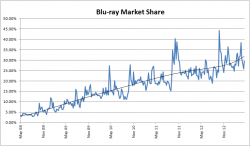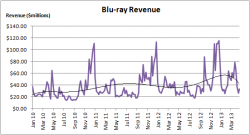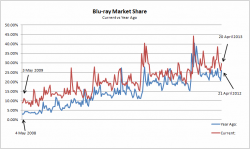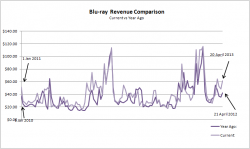Welcome to another edition of our annual Blu-ray sales analysis, even if this one is slightly late. It’s been more of the same for Blu-ray since the last issue in this series here, and with increasing competition from streaming, and potential future competition from 4K, it’s worth having a look at where Blu-ray is.
The data used in this analysis derives from our weekly updates, based on figures released by Home Media Magazine. Some of the historical figures you’ll see have also been adjusted, due to slight tweaking of the metrics used by HMM to create these sets of data, although the changes have been very subtle and does not change the bigger picture in any way.
The first set of graphs show Blu-ray market share (Blu-ray and combo market share as a percentage of all disc sales) through the five year period that I have tracked them, with the release milestones pointed out.
As the graph is getting perhaps a bit too wide, here’s a condensed version that allows you to see Blu-ray’s market share rise more clearly.
We’ve had our fair share of milestone releases in the 52 week period since the last “State of Play” feature. While there’s no Star Wars this time around, we do have The Avengers and The Hobbit, the former responsible for the peak in the graphs above. The new market share record is now 44.23%, beating the 40.22% set by the release of The Lion King back in 2012. The up and down nature of the weekly results show that market share, like revenue, is very much release dependent. A good “A-lister” this week or a Blu-ray exclusive can get market share and revenue rising fast, but a slow week, and it goes down again. But the rising trend is clear, especially in the second graph above. The trendline just breaks above the 30% mark at the end of April 2013, and that’s probably a fair reflection of where Blu-ray market share is, or will be soon enough.
For this latest 52 week period ending 20th April 2013, the average weekly Blu-ray market share figure was 27.57%. This compares to 23.67% from the previous 52 week period. This is in-line with the 4-6% annual increase in market share that Blu-ray has experienced since inception.
It’s worth noting that Blu-ray’s rising market share has as much to do with DVD’s decline as it has to do with actual rise in Blu-ray sales, probably more so. The rise in spending in digital streaming and downloading is one of the major factors in the decline of DVD sales, in addition to the rising popularity of Blu-ray.
For Blu-ray revenue, the trend is less clear, although I have less data in this regard compared to market share (just under three and a half year’s worth), other than that there is definitely a seasonal trend within the overall trend, peaking unsurprisingly during the holidays sales period.
Analyzing the peaks, we’re seeing a gradual rise from year to year, and the trendline reflects this as well. Again, you can see that revenue is both release dependent (when the revenue peaks line up with the market share peaks) and seasonal dependent (when revenue peaks does not line up with market share peaks). Taking averages of these weekly results, this latest 52 week period yielded an average weekly revenue figure of $44.84 million. This compares with $39.44m and $34.05m from the last two 52 week periods, producing a trend that seems to indicate a $5 million rise in average weekly revenue every year.
The last two set of graphs shows a comparison of weekly market share figures with the same figure from a year ago, and the same comparison but with revenue figures.
These two graphs are less indicative than the other graphs, but they’re interesting in that they show the seasonal effect in full force – note that the peaks and troughs occur roughly at the same time every year, for both market share and revenue. The more noticeable gap between the year-on-year market share comparison, and the less noticeable gap between the revenue version of the same comparison, again highlights that other factors exists (ie. decline of DVD sales) when taking into account market share.
In conclusion, it’s been another steady year of growth for Blu-ray. It looks as if it will take a while for Blu-ray to become the dominant disc format (dominant as in more than 50% market share on average), but on the whole, the format looks in healthy growth.





